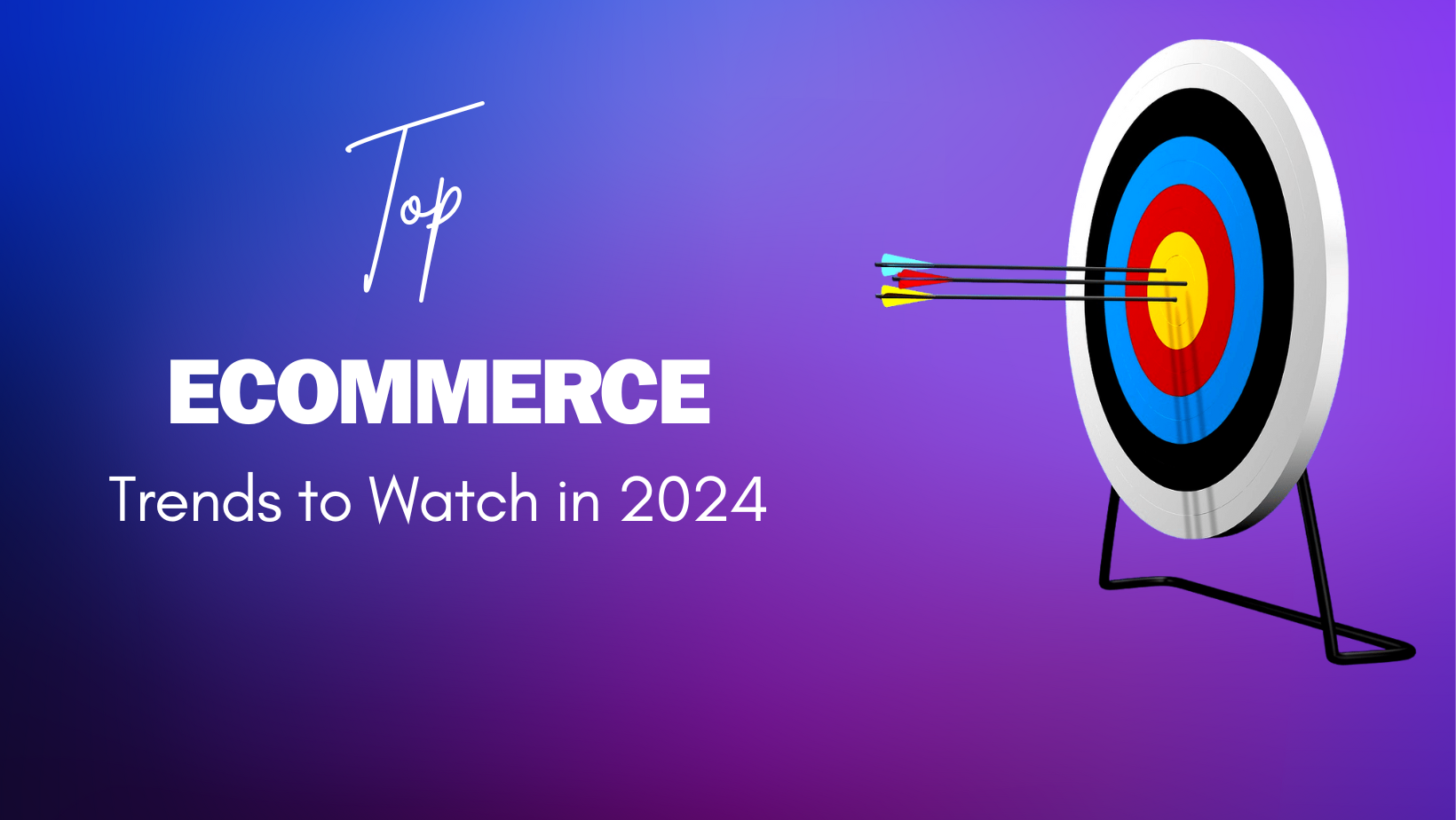
In today’s fast-paced digital world, ecommerce continues to evolve at a breakneck pace. As we look ahead to 2024, several key trends are set to shape the future of online shopping. These trends are driven by technological advancements, shifting consumer behaviors, and the ongoing need for businesses to adapt and innovate. In this article, we’ll explore the top ecommerce trends to watch in 2024, providing valuable insights for businesses looking to stay ahead of the curve.
The Rise of Artificial Intelligence and Machine Learning

Artificial Intelligence (AI) and Machine Learning (ML) are revolutionizing ecommerce by enabling more personalized shopping experiences. AI-driven algorithms analyze customer data to deliver tailored product recommendations, improving customer satisfaction and increasing sales. In 2024, expect to see even more sophisticated AI applications of ecommerce trends, such as chatbots that provide real-time customer support and AI-powered inventory management systems that optimize stock levels based on demand predictions.
Augmented Reality (AR) Enhancing Shopping Experiences
Augmented Reality (AR) is transforming the way consumers shop online by bridging the gap between physical and digital experiences. AR allows customers to visualize products in their own environment before making a purchase. For instance, furniture retailers use AR to let customers see how a sofa would look in their living room. In 2024, AR technology will become more widespread ecommerce trends, providing immersive shopping experiences that boost customer confidence and reduce return rates.
The Growth of Mobile Commerce
Mobile commerce, or m-commerce, continues to gain traction as more consumers use smartphones for online shopping. The convenience of mobile devices, combined with improved mobile payment solutions, has made m-commerce a significant driver of ecommerce growth. In 2024, businesses will need to prioritize mobile-friendly website designs, fast-loading pages, and seamless checkout processes to capture the mobile-savvy audience.
Social Commerce Expanding Its Reach
Social commerce is the integration of ecommerce with social media platforms, allowing users to purchase products directly from their favorite social networks. Platforms like Instagram, Facebook, and TikTok have introduced shopping features that enable businesses to reach potential customers where they spend most of their time. In 2024, social commerce will continue to expand in top ecommerce trends, with more brands leveraging influencer partnerships and user-generated content to drive sales.
Sustainability and Ethical Shopping
Consumers are increasingly prioritizing sustainability and ethical practices when making purchasing decisions. Brands that demonstrate a commitment to environmental and social responsibility are gaining favor with conscious shoppers. In 2024, ecommerce businesses will need to adopt sustainable practices, such as using eco-friendly packaging, sourcing ethical products, and providing transparency about their supply chains, to attract and retain customers.
Voice Commerce on the Rise
Voice commerce, driven by the popularity of voice-activated assistants like Amazon’s Alexa and Google Assistant, is set to become a significant ecommerce trend in 2024. Moreover, voice searches are becoming more common, and consumers are using voice commands to shop online, make inquiries, and reorder products. Businesses will need to optimize their websites for voice search and develop strategies to capitalize on this growing trend.
The Importance of Omnichannel Retailing
Omnichannel retailing refers to providing a seamless shopping experience across multiple channels, including online stores, physical locations, mobile apps, and social media. In 2024, consumers will expect a consistent and integrated experience regardless of how they choose to shop. Businesses that successfully implement omnichannel strategies will enhance customer satisfaction and loyalty by ensuring a smooth transition between different shopping channels.
Subscription-Based Models Gaining Popularity
Subscription-based models offer a convenient and personalized shopping experience by delivering products to customers on a recurring basis. This trend has gained momentum in recent years, with subscription boxes for everything from beauty products to meal kits. In 2024, more businesses will adopt subscription services to create steady revenue streams and build long-term relationships with customers.
The Emergence of Cryptocurrencies in Ecommerce
Cryptocurrencies are making their way into the ecommerce landscape as more consumers and businesses explore the benefits of digital currencies. Cryptocurrencies like Bitcoin and Ethereum offer secure and decentralized payment options, appealing to tech-savvy shoppers. In 2024, expect to see an increase in ecommerce platforms accepting cryptocurrencies, providing customers with more payment choices and enhancing transaction security.
Enhanced Data Security and Privacy Measures
As ecommerce grows, so do concerns about data security and privacy. Consumers are becoming more aware of the risks associated with online shopping and expect businesses to protect their personal information. In 2024, ecommerce companies will need to invest in robust security measures, such as encryption and two-factor authentication, to safeguard customer data and build trust.
Hyper-Personalization Through Data Analytics
Data analytics is key to understanding customer behavior and preferences. By leveraging big data, ecommerce businesses can deliver hyper-personalized experiences, such as targeted marketing campaigns and customized product recommendations. In 2024, the use of advanced data analytics tools will become more prevalent, enabling businesses to anticipate customer needs and enhance their shopping experiences.
The Role of Influencer Marketing
Influencer marketing continues to be a powerful tool for ecommerce businesses. Influencers have the ability to reach large audiences and build trust with their followers. It also making them valuable partners for promoting products and driving sales. In 2024, expect to see more brands collaborating with influencers across various niches to create authentic and engaging content that resonates with their target audience.
Advanced Payment Solutions
The payment process is a crucial part of the ecommerce experience. In 2024, businesses will need to offer a variety of advanced payment solutions to cater to diverse customer preferences. This includes digital wallets, buy now, pay later (BNPL) services, and contactless payments. Streamlining the payment process and providing secure, convenient options will be essential for reducing cart abandonment and enhancing customer satisfaction.
Fast and Flexible Shipping Options
Shipping speed and flexibility are critical factors in the ecommerce customer experience. Consumers expect quick and reliable delivery options, with many willing to pay extra for faster shipping. In 2024, ecommerce businesses will need to optimize their logistics and supply chain operations to offer same-day or next-day delivery, as well as convenient options like click-and-collect and curbside pickup.
The Impact of 5G Technology
The rollout of 5G technology is set to revolutionize ecommerce by providing faster internet speeds and improved connectivity. This will enhance the online shopping experience, enabling high-quality video streaming, augmented reality applications, and real-time customer interactions. In 2024, businesses that leverage 5G technology will be able to offer more engaging online experiences, attracting tech-savvy consumers.
Customer Loyalty Programs and Retention Strategies
Retaining existing customers is more cost-effective than acquiring new ones, making customer loyalty programs a valuable strategy for ecommerce businesses. In 2024, companies will focus on creating personalized loyalty programs that reward repeat customers with exclusive discounts, early access to new products, and other incentives. Effective retention strategies will help businesses build long-term relationships and increase customer lifetime value.
Conclusion
As we move into 2024, the ecommerce landscape will continue to evolve, driven by technological advancements and changing consumer preferences. By staying informed about these top ecommerce trends, businesses can position themselves for success in an increasingly competitive market. From AI and AR to mobile commerce and social commerce, the future of ecommerce is full of exciting opportunities. Embracing these trends and adapting to new challenges will be key to thriving in the dynamic world of online retail.